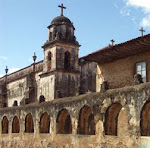We leave at 9:00 a.m. from La Jacaranda in Patzcuaro and pick up the
libre, the old road to Uruapan. The winter sun is low and we drive through chill, misty air and the varying shades of green of the deciduous and pine forest that is typical of the Michoacán highlands. We intersect with the
cuota, the toll road that will take us to Zihuatanejo. Our first stop is at a toll booth, where we begin to buy our way in increments to the coast: Pesos $26 for the first installment, then $29, then $28, then $52 and finally $52 again. As we expect, the weather is warm 45 minutes west and some 2,000 feet lower than Pátzcuaro.
We have a few rules for travel by car in Mexico. First, take cash for gas, because it is the only way one can purchase it. Second, allow plenty of daylight hours to reach one's destination--we don't travel at night for a number of safety reasons. Also, be aware that most of the good highways are toll roads and they are not inexpensive. Finally, always start out with a full tank of gas and fill up whenever possible.
The stretch of highway from Uruapan to the coast winds through some desolate areas of the
tierra caliente. We drive up to El Tamarindo in 4 hours (minus 5 minutes), with stops only to pay tolls and one for the
baño.

We savor our much-awaited, tasty
huachinango at La Perla Restaurant on Playa La Ropa . My book signing for "Intercultural Communication: A Practical Guide" is in the evening at Coconut's restaurant in the center of Zihuatanejo and I meet some very interesting people. Then we dine well at Coconut's with Catherine Krantz of
Another Day in Paradise and delightful Debbie, manager of Coconuts, and her husband Jeff. A special appetizer not on the menu is delicious: tempura fresh oysters.

We make it to bed after midnight, late for us--we are morning people. It has been a good day.
P.S. - "Tony" Ixtapa is not as tony as it was. The destination now caters more to budget all-inclusive package travelers.






.JPG)


.JPG)
.jpg)
.jpg)
.JPG)
.JPG)
.jpg)





.JPG)
.JPG)
.jpg)
.jpg)
.JPG)
.JPG)
.JPG)
.JPG)
.jpg)
.JPG)

.jpg)
.jpg)



















